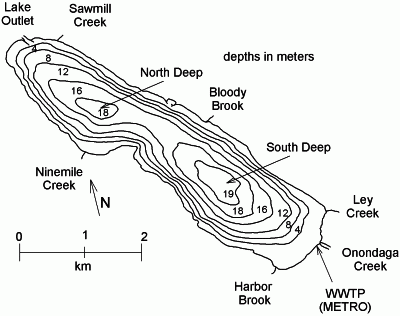|
||||||||||||||||||||||
Onondaga Lake is a saline (~ 1 g/L), dimictic (mixes vertically twice per year) lake located in metropolitan Syracuse, NY (watershed population approximately 450,000). The lake has a surface area of 12.0 km2 (4.6 square miles), a volume of 131 x 106 m3 (35 billion gallons), and mean and maximum depths of 10.9 m (36 feet) and 19.5 m (64 feet), respectively. The lake flushes rapidly (that is, its water volume is replace rapidly), approximately four times per year on average, and thus responds rapidly to changes in external loading. This is much more frequently than nearby Skaneateles Lake which flushes once every 12 years. The lake is described as having two (north and south) basins (Figure 1). The largest inflow (31% of the total) is from Onondaga Creek that enters at the southern end after passing through the City of Syracuse (Figure 1). Effluent from the regional domestic wastewater treatment facility (Metro), the third largest of the inflows (19%), and two smaller tributaries also enter the southern basin. The lake has a single outflow to the Seneca River. The lake was oligomesotrophic (low amount nutrients and therefore low amount of algae) before European settlement in the late 1700s. As the lake’s watershed was urbanized and developed, inputs of industrial and domestic wastes increased which led to severe degradation and loss of associated resources such as its cold-water fishery. Costly (approximately one billion dollars) rehabilitation programs for domestic waste inputs and industrial residuals are underway.
Rehabilitation efforts for the domestic waste problems have targeted both the direct discharge of effluent from Metro and irregular inputs of dilute raw sewage from combined sewer overflows (CSOs) into lake tributaries during runoff events. Through the early 2000s, the Metro discharge caused severe water quality problems in the lake associated with (1) high concentrations of ammonia and nitrite nitrogen, which violated standards to protect against their toxic effects, and (2) severe manifestations of cultural eutrophication (elevated algae growth) from excessive phosphorus (P) loading. Implementation of year-round nitrification treatment (2004) eliminated in-lake violations of the nitrogen toxicity standards, decreased the associated oxygen demand, and increased concentrations of nitrate.
|
- high concentrations of algae
- poor clarity
- rapid loss of dissolved oxygen (DO) from the hypolimnion (see Temperature)
- large hypolimnetic accumulations of DO-demanding reduced by-products of anaerobic metabolism (see Dissolved Oxygen)
- severe depletion of DO in the upper waters during turnover.
A series of management actions were taken to reduce P loading from Metro since 1970, that reduced effluent concentrations by approximately 120-fold (Figure 2). The most recent upgrade in 2005 reduced the effluent TP from approximately 300 µg/L (2000-2002) to ≤ 100 µg/L (by 2006). The reductions in P loading from Metro transformed the lake to mesotrophy, as supported by values of the trophic state metrics of epilimnetic TP and Chl concentrations and SD. Depletion rates of hypolimnetic DO, as represented by the areal hypolimnetic oxygen deficit (AHOD, g/m2/d), also improved. Contemporary management plans for the lake call for further improvements in trophic state, primarily through reductions in P loading from the tributaries, to be implemented over the next 12 years.
Onondaga Creek is important with respect to water quality concerns for the lake because
|
- it delivers most of the CSO inputs
- it receives “leaky” sewer inputs
- it is the second largest source of bioavailable P (after Metro)
- it is the largest source of sediment and turbidity
This stream is more dense than the upper waters of the lake (i.e., negatively buoyant; ∆ρ positive, Figure 3) over the late spring to early fall interval because of its lower temperature (T) and higher salinity, both associated with ground water inputs. The extent of its negative buoyancy is diminished during runoff events, largely from the decreases in salinity. Other inflows to the south basin have lower salinities than the lake and lower Tn levels than Onondaga Creek. These characteristics make SC and Tn valuable tracers to track the transport of Onondaga Creek within the south basin of the lake during dry and wet weather intervals, respectively. The density of Metro’s effluent is generally lower than Onondaga Creek. Though during some portion of the summer the Metro effluent is slightly denser than the upper lake water resulting in local plunging, most of the effluent enters the hypolimnion.
Mercury (Hg) discharged to the lake from a chlor-alkali manufacturing facility (closed 1986) resulted in continuing contamination of the water column, biota, and sediments. One of the manifestations of contamination was the annual enrichment of the hypolimnion with methyl Hg (the most toxic form) from sediment release in late summer, following the development of anaerobic conditions (i.e., loss of both DO and NO3-), and subsequent increases in the upper waters during fall turnover. The increase in NO3- in the lake from the Metro treatment upgrade delayed its depletion in the hypolimnion and thereby diminished the subsequent accumulation of methyl Hg. This was followed by a successful three year (2011-2013) lake-wide pilot study in which further hypolimnetic addition of NO3- to prevent its depletion was demonstrated to eliminate mobilization of methyl Hg and subsequent increases in the upper waters in fall.
|
Upstate Freshwater Institute (UFI) is a not-for-profit [501 (C) (3)] research corporation (established in 1981) dedicated to the improvement of water quality and the advancement of freshwater research. We are a NELAC/NELAP accredited laboratory (NY Laboratory ID No. 11462, EPA Laboratory Code NY01276) since 1994.

224 Midler Park Dr
Syracuse, NY 13206
Fax: 315-431-4969
Phone: 315-431-4962










